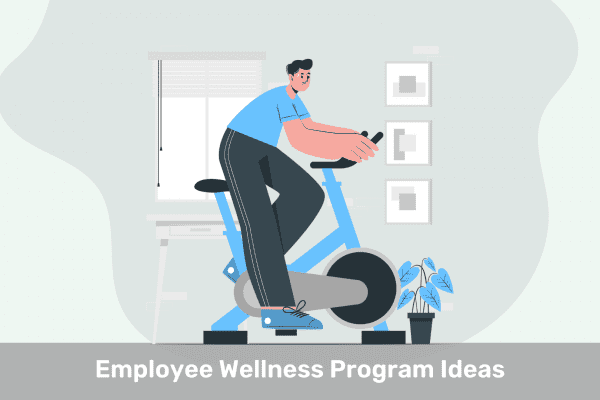Introduction
We all know that work isn’t just about the tasks we tackle from 9 to 5. It’s about feeling good, staying inspired, and finding that sweet spot where our well-being thrives. That’s where the “9 Dimensions of Wellness at Work” come in – it’s like a treasure map that guides us toward a happier, healthier work life.
Think about it: your well-being isn’t just about hitting the gym or munching on veggies (although those are important too!). It’s a puzzle made up of nine different pieces, each contributing to your overall health and happiness while you’re on the clock.
According to Gallup, employees who have strong well-being are 35% more likely to have higher job performance. That’s like having a secret superpower that helps you shine at work! But here’s the kicker – only 7% of employees feel they’re at their peak well-being level.
So, get ready to embark on a journey through these nine dimensions. We’ll explore everything from keeping your mind sharp and your stress levels in check, to finding your inner zen and even rocking those financial goals. It’s time to unlock the potential of your well-being and create a workplace where you not only thrive but truly flourish. So, let’s dive into the world of the “9 Dimensions of Wellness at Work” – where health meets happiness, and work becomes a place where you not only succeed but also truly shine.
The 9 Dimensions of Wellness
The term “Dimensions of Wellness” refers to the various interconnected aspects or facets of a person’s overall well-being. Just as a three-dimensional object has length, width, and height, our well-being is multi-dimensional, encompassing different aspects of our lives that contribute to our overall health, happiness, and quality of life.
The concept of dimensions of wellness acknowledges that well-being is not just a single, linear measure. Instead, it recognizes that our health and wellness are influenced by a variety of factors, and these factors are interconnected and interdependent.
The “Dimensions of Wellness” model typically includes several different dimensions, such as physical, emotional, social, intellectual, occupational, environmental, financial, spiritual, and cultural wellness. Each of these dimensions represents a unique area of focus that contributes to an individual’s overall well-being.
By recognizing and addressing these various dimensions, individuals and organizations can take a holistic approach to wellness, understanding that good health and happiness involve more than just physical health. This comprehensive perspective helps individuals strive for a well-rounded and fulfilling life, taking into account the many different aspects that contribute to their overall sense of well-being.
-
Physical Wellness

The physical dimension of wellness is the first dimension of 9 dimensions of wellness. It is the cornerstone of a strong foundation – it forms the basis upon which our overall well-being is built. It encompasses the state of our physical health, our ability to maintain a balanced lifestyle, and our choices that directly impact our bodies.
See your body as a finely tuned machine. Just as a car needs proper fuel, regular maintenance, and care, your body requires similar attention. This dimension focuses on nurturing your body through healthy habits, regular exercise, balanced nutrition, and preventive measures.
Key Aspects of Physical Wellness:
- Regular Exercise: Engaging in physical activity not only strengthens muscles and bones but also releases endorphins, boosting mood and reducing stress. Incorporating moderate exercise, whether it’s brisk walking, jogging, or dancing, contributes to improved cardiovascular health and overall fitness.
- Balanced Nutrition: Fueling your body with a well-rounded diet rich in nutrients ensures you have the energy you need to power through your day. A diet abundant in fruits, vegetables, lean proteins, and whole grains supports proper digestion, enhances immunity, and maintains a healthy weight.
- Adequate Rest: Sleep is your body’s way of recharging. Prioritizing quality sleep helps regulate hormones, supports cognitive function, and aids in muscle recovery. Aim for 7-9 hours of uninterrupted sleep each night.
- Preventive Care: Regular health screenings and check-ups act as proactive measures to catch potential health issues early. Monitoring blood pressure, cholesterol levels, and immunizations helps maintain optimal health and prevents future complications.
- Stress Management: Chronic stress can take a toll on your physical well-being. Practicing relaxation techniques such as deep breathing, meditation, and yoga can help lower stress hormones and promote a sense of calm.
- Hydration: Adequate water intake is essential for bodily functions, from digestion to temperature regulation. Aim for at least 8 glasses (about 2 liters) of water daily.
The Impact of Physical Wellness:
Prioritizing physical wellness doesn’t just benefit your body; it has a ripple effect on your overall quality of life. When you take care of your physical health, you experience higher energy levels, improved mood, better sleep, and a reduced risk of chronic diseases.
In the grand scheme of wellness, the physical dimension serves as a strong foundation. By making conscious choices and adopting healthy habits, you’re nurturing the very vessel that carries you through life’s journey. Remember, a healthier body paves the way for a more vibrant and fulfilling life.
-
Mental Wellness

Amidst the bustling world we live in, our mental well-being stands as a key pillar of our overall health. The mental dimension of wellness delves into the realm of our thoughts, emotions, and psychological state. It is one of the important dimension in 9 dimensions of wellness. It’s like the harmony within a symphony – when it’s in tune, everything seems brighter, and life feels more fulfilling.
Key Aspects of Mental Wellness:
- Emotional Resilience: This is the ability to cope with challenges, bounce back from setbacks, and adapt to change. It’s like having a sturdy umbrella that shields you from the storms of life.
- Stress Management: Juggling work, responsibilities, and daily pressures can be overwhelming. Learning healthy coping mechanisms, like deep breathing or mindfulness, equips you with tools to manage stress and maintain your inner calm.
- Positive Self-Image: Embracing who you are and appreciating your unique qualities is essential. It’s like celebrating your own masterpiece in a world full of art.
- Self-Care: Just as a garden needs nurturing, your mind requires care too. Engaging in activities you love, spending time with loved ones, and practicing relaxation techniques are like tending to the garden of your mind.
- Mindfulness and Presence: Being fully present in the moment, without judgment, fosters a sense of clarity and peace. It’s like savoring a delicious meal slowly, relishing every flavor.
Impact of Mental Wellness:
Cultivating mental wellness isn’t just a feel-good endeavor; it significantly influences every facet of your life. Consider this: over 90% of people who experience mental health challenges report an improvement in their overall well-being when they receive proper support and treatment (National Alliance on Mental Illness). Your mental well-being impacts your:
- Relationships: Nurturing your emotional resilience enhances your ability to connect deeply and empathize with others.
- Productivity: A clear and focused mind elevates your work performance and creativity.
- Physical Health: Mental wellness positively affects immune function, heart health, and even longevity.
- Decision-Making: When your mind is balanced, you make informed choices aligned with your values.
Remember, just as you nourish your body, tending to your mental dimension is vital. By embracing emotional resilience, managing stress, and practicing self-care, you’re investing in a stronger, happier, and more fulfilled you. Like a garden in full bloom, your mental well-being can radiate positivity and touch every aspect of your life.
-
Intellectual Wellness

The intellectual dimension from the 9 dimensions of wellness – a crucial piece of the well-being puzzle that focuses on keeping our minds sharp and engaged. Let’s take a closer look at this aspect, its key components, and the impact it has on our overall quality of life.
Key Aspects of Intellectual Wellness:
- Lifelong Learning: Engaging in continuous learning, whether through formal education or self-directed exploration, helps keep your brain active and curious.
- Problem Solving: The ability to analyze challenges, make decisions, and find creative solutions contributes to intellectual growth.
- Critical Thinking: Evaluating information, considering different perspectives, and making informed judgments are essential skills for intellectual well-being.
- Curiosity: A thirst for knowledge and a willingness to explore new ideas, concepts, and experiences foster intellectual development.
- Creativity: Expressing yourself through various forms of art, innovation, and original thinking contributes to intellectual enrichment.
Impact of Intellectual Wellness:
Nurturing your intellectual dimension of wellness has a profound impact on various areas of your life:
- Enhanced Problem Solving: Sharpening your critical thinking skills empowers you to approach challenges more effectively, making you a valuable asset in both personal and professional situations.
- Personal Growth: Lifelong learning and curiosity lead to personal growth and self-discovery, helping you uncover new passions and interests.
- Professional Success: Intellectual wellness equips you with the skills needed to excel in your career, adapt to changes, and innovate within your field.
- Emotional Well-being: Engaging your mind can reduce stress, boost self-confidence, and improve your overall mental health.
- Social Interaction: Intellectual pursuits provide conversation topics, fostering connections and meaningful interactions with others.
- Adaptability: Being open to new ideas and perspectives enhances your ability to adapt to changing circumstances and embrace lifelong learning.
Incorporating activities that stimulate your mind, such as reading, solving puzzles, attending lectures, or engaging in hobbies, can help you maintain and enhance your intellectual wellness. Remember, just like physical exercise, giving your brain a regular workout is essential for a well-rounded and fulfilling life. So, keep your mind curious, your thoughts sharp, and your intellectual dimension thriving!
-
Spiritual Wellness

In the tapestry of our well-being, the spiritual dimension weaves a profound thread, enriching our lives with purpose, connection, and inner peace. While often associated with religious beliefs, spiritual wellness transcends denominations, encompassing a sense of meaning, purpose, and connection to something greater than ourselves.
Key Aspects of Spiritual Wellness:
- Meaning and Purpose: Spiritual wellness involves finding significance in life beyond the surface. It’s about understanding our unique role in the world and aligning our actions with our core values.
- Inner Peace: This aspect emphasizes tranquility and a calm mind. Cultivating inner peace through practices like gratitude meditation and mindfulness helps manage stress and enhances emotional well-being.
- Connection to Others: Spiritual wellness fosters a sense of connection to fellow humans and the environment. It promotes empathy, compassion, and a desire to contribute positively to the world.
- Mindfulness and Reflection: Engaging in self-reflection and being present in the moment deepen our spiritual awareness. It encourages us to explore our thoughts, emotions, and experiences.
- Openness to Mystery: Embracing the unknown and being receptive to life’s mysteries can lead to a sense of wonder and curiosity that enriches our spiritual journey.
Impact of Spiritual Wellness:
Cultivating spiritual wellness can yield profound benefits across various aspects of our lives:
- A strong spiritual foundation can help us cope with challenges and setbacks, enhancing emotional resilience.
- Engaging in spiritual practices like meditation and mindfulness can significantly lower stress levels, promoting overall mental well-being.
- Nurturing spiritual connections fosters empathy and compassion, deepening our relationships with others.
- Self-reflection and mindfulness lead to better understanding of ourselves, promoting personal growth and development.
- When we find meaning and purpose in our lives, we experience a heightened sense of fulfillment and life satisfaction.
In the bustling world of work, tending to our spiritual dimension can provide a sanctuary of balance and perspective. Whether through religious practices, meditation, nature contemplation, or acts of kindness, embracing spiritual wellness enriches our journey toward holistic well-being. Remember, the spiritual dimension isn’t about doctrine; it’s about nourishing the soul, finding purpose, and adding depth and meaning to our lives.
-
Social Wellness

The social dimension in the 9 dimensions of wellness is a vital thread that weaves connections, friendships, and a sense of belonging. Picture this dimension as the heart of your social life – a realm where relationships flourish, laughter resonates, and mutual support abounds. Let’s delve into the key aspects of the social dimension and discover how it shapes our well-being.
Key Aspects of Social Wellness:
- Healthy Relationships: Cultivating meaningful connections with family, friends, colleagues, and even acquaintances fosters a sense of camaraderie and emotional support.
- Effective Communication: The art of listening and expressing oneself nurtures understanding, prevents misunderstandings, and strengthens bonds.
- Boundaries: Setting healthy boundaries in relationships ensures mutual respect and prevents emotional burnout.
- Social Engagement: Participating in group activities, clubs, and social gatherings enhances a sense of belonging and combats feelings of isolation.
Strategies for Enhancing Social Wellness:
- Reach Out: Initiate conversations, make plans, and reconnect with friends and family.
- Practice Active Listening: Give your full attention when others speak and show genuine interest.
- Join Groups: Participate in clubs, sports, or social organizations that align with your interests.
- Set Digital Boundaries: Balance online interactions with face-to-face connections to foster genuine relationships.
In the realm of social wellness, nurturing connections is akin to tending to a blossoming garden – it requires effort, care, and an understanding of the unique beauty each relationship brings. By prioritizing social well-being, we enrich our lives, boost our mental and physical health, and create a harmonious symphony of social connections that resonate with joy and fulfillment.
-
Environmental Wellness

This dimension from the 9 dimensions of wellness focuses on the interactions between you and your surroundings, including the spaces you inhabit, the air you breathe, and the impact you have on the planet. Let’s dive into this essential aspect of well-being and explore key aspects and strategies to enhance your environmental wellness.
Key Aspects of Environmental Wellness:
- Physical Space: Your immediate surroundings – be it your home, workplace, or community – play a significant role in your well-being. A clean, organized, and aesthetically pleasing environment can reduce stress and promote a sense of calm.
- Nature Connection: Spending time in nature has been linked to reduced stress, improved mood, and enhanced mental clarity. Connecting with the natural world through outdoor activities, walks, or even indoor plants can boost your well-being.
- Sustainability: Making eco-friendly choices, such as reducing waste, conserving energy, and using sustainable products, contributes to both personal and planetary well-being.
Strategies to Enhance Your Environmental Wellness:
- Create a Healthy Home Space: Declutter and organize your living space to create a tranquil environment. Use natural light, incorporate plants, and choose eco-friendly materials to improve indoor air quality.
- Embrace Outdoor Activities: Spend time outdoors regularly, whether it’s hiking, gardening, or simply taking a leisurely stroll in a nearby park. Nature’s healing effects can work wonders for your overall wellness.
- Practice Sustainable Living: Reduce, reuse, and recycle to minimize your ecological footprint. Opt for energy-efficient appliances, reduce water wastage, and choose reusable alternatives to single-use items.
- Connect with Nature: Incorporate nature into your routine, whether it’s by setting up a small indoor garden, going for regular nature walks, or practicing mindfulness outdoors.
- Participate in Community Initiatives: Join local environmental groups or community clean-up events to contribute to a cleaner and healthier environment.
Remember, your well-being is interconnected with the well-being of the planet. By nurturing your environmental wellness, you not only improve your immediate surroundings but also contribute to a healthier and more sustainable world for current and future generations. So, take those eco-friendly steps, connect with nature, and make choices that benefit both you and the environment – because wellness goes beyond just the individual, it extends to the world we live in.
-
Financial Wellness

When we talk about well-being, it’s not just about feeling good physically or mentally – it’s also about finding balance and stability in every area of our lives. That includes our finances. Welcome to the financial dimension of wellness, a crucial piece of the wellness puzzle that plays a significant role in our overall health and happiness in the 9 dimensions of wellness.
Key Aspects of Financial Wellness:
Picture your financial well-being as a puzzle with several key pieces:
- Budgeting and Saving: Creating a budget helps you track your expenses and income, while saving ensures you have a safety net for unexpected situations.
- Debt Management: Handling debt responsibly and having a plan to pay it off can reduce stress and improve your financial outlook.
- Investing and Retirement: Planning for the future by investing wisely and saving for retirement sets the stage for long-term financial security.
- Financial Literacy: Understanding financial concepts and making informed decisions about money empowers you to take control of your financial journey.
Strategies to Enhance Financial Wellness:
Ready to level up your financial game? Here are some practical strategies to boost your financial dimension of wellness:
- Create a Realistic Budget: Track your income and expenses to see where your money goes. Make adjustments to prioritize saving and paying off debt.
- Build an Emergency Fund: Set aside money for unexpected expenses, like medical bills or car repairs. Aim for three to six months’ worth of living expenses.
- Tackle Debt Methodically: Focus on paying off high-interest debts first, while making minimum payments on others. Consider debt consolidation if it helps streamline payments.
- Invest for the Future: Explore retirement accounts like 401(k)s or IRAs. Diversify your investments to manage risk and potentially grow your wealth over time.
- Seek Financial Education: Take advantage of workshops, online resources, or financial advisors to enhance your financial literacy and make informed decisions.
- Set Financial Goals: Define short-term and long-term financial goals, such as saving for a vacation, buying a home, or funding your children’s education.
Remember, financial wellness isn’t about having a certain amount of money – it’s about managing what you have wisely and setting yourself up for a stable and fulfilling future. By taking proactive steps to enhance your financial dimension of wellness, you’re investing in your overall well-being and securing a more confident financial future.
Read More: Employee Financial Wellness Strategies
-
Occupational Wellness

The occupational dimension of wellness is like the master conductor of life’s orchestra – it’s all about finding the right balance between work, personal pursuits, and a sense of purpose. Think of it as the part of your well-being that ensures your job aligns with your passions, values, and ambitions, making your daily grind feel less like work and more like a fulfilling journey.
Read Further: What is Occupational Wellness?
Key Aspects:
- Job Satisfaction: This is all about enjoying what you do. A satisfying job sparks enthusiasm and motivation, making your workdays feel like a rewarding adventure.
- Career Growth: The desire to keep learning and advancing in your field. Setting goals, seeking new challenges, and enhancing skills are essential components.
- Work-Life Balance: Striking the right equilibrium between work responsibilities and personal time. It’s about avoiding burnout and having space for family, hobbies, and relaxation.
- Meaningful Work: Feeling that your job has a purpose beyond just a paycheck. Contributing to a cause or making a difference adds depth to your professional life.
Impact:
A healthy occupational dimension isn’t just about clocking in and out; it’s a game-changer for your overall well-being.
- When your job is in sync with your passions and values, stress levels tend to decrease. You’re more likely to approach challenges with resilience and a positive mindset.
- A fulfilling job often translates to increased focus and productivity. When you’re engaged and motivated, you’re more likely to excel in your tasks.
- Job satisfaction and a sense of purpose can act as buffers against mental health issues. They contribute to a sense of fulfillment and overall happiness.
- Striking the right balance between work and personal life leads to improved mental and emotional well-being. You’re better equipped to handle both realms with grace and energy.
- When you’re invested in your career’s growth and have a sense of purpose, you’re more likely to stay committed and achieve long-term success.
In a nutshell, the occupational dimension isn’t just about the daily grind; it’s about weaving your work into the fabric of your life in a way that feels meaningful and rewarding. When your career aligns with your passions and values, it becomes a powerful tool in crafting a fulfilling and balanced life journey.
-
Cultural Wellness

This dimension from the 9 dimensions of wellness recognizes that our identity isn’t just about who we are as individuals; it’s also about the cultures we belong to, the traditions we cherish, and the communities we’re part of. Let’s dive into what this dimension entails, its key aspects, and the profound impact it has on our overall wellness.
Key Aspects of Cultural Dimension:
The cultural dimension of wellness encompasses a wide range of aspects that shape our sense of self within a larger cultural context. Here are some key aspects:
- Heritage and Identity: Embracing and celebrating one’s cultural heritage forms a core part of this dimension. It involves understanding and appreciating one’s ancestry, traditions, language, and history.
- Community Connection: The cultural dimension thrives within communities where people share similar cultural backgrounds. It’s about creating bonds, fostering unity, and preserving cultural practices together.
- Respect for Diversity: While celebrating one’s culture is important, this dimension also emphasizes recognizing and respecting the diverse cultures that exist around us.
- Cultural Competence: Developing cultural competence involves understanding and interacting with people from different cultural backgrounds respectfully and effectively.
Incorporating Cultural Wellness:
To nurture the cultural dimension of wellness, it’s important to:
- Celebrate cultural heritage and diversity through events and activities.
- Educate and raise awareness about different cultures in the workplace or community.
- Foster an inclusive environment where diverse cultural perspectives are valued.
By embracing the cultural dimension of wellness, individuals and organizations can create a tapestry of inclusivity, understanding, and unity. Remember, your cultural identity is a vibrant thread that contributes to the beautiful fabric of your well-being.
How can Employers address the 9 Dimensions of Wellness in the workplace?
Promoting a well-rounded and thriving workforce involves addressing the nine dimensions of wellness in the workplace. By implementing strategies that cater to each dimension, employers can create a holistic wellness program that supports employees’ overall well-being. Here’s how employers can address each dimension:
Physical Wellness:
-
- Offer onsite fitness classes or gym memberships.
- Provide ergonomic workstations and encourage regular breaks.
- Organize wellness challenges that focus on physical activity.
Emotional Wellness:
-
- Provide access to counseling services and mental health resources.
- Offer stress management workshops and mindfulness sessions.
- Create a supportive and open communication culture.
Social Wellness:
-
- Organize team-building activities and social events.
- Establish employee resource groups that celebrate diversity.
- Encourage collaboration and a sense of belonging.
Intellectual Wellness:
-
- Provide opportunities for skill development and continuing education.
- Offer workshops on creativity, problem-solving, and critical thinking.
- Support employees in pursuing their intellectual interests.
Occupational Wellness:
-
- Offer career development programs and pathways for growth.
- Promote work-life balance through flexible scheduling and remote work options.
- Recognize and reward achievements to boost job satisfaction.
Environmental Wellness:
-
- Create a comfortable and aesthetically pleasing workspace.
- Implement sustainable practices and initiatives, such as recycling programs.
- Provide access to natural light and green spaces.
Financial Wellness:
-
- Offer financial planning workshops and resources.
- Provide retirement planning assistance and investment options.
- Promote financial well-being through benefits like health savings accounts.
Spiritual Wellness:
-
- Designate quiet spaces for meditation, reflection, or prayer.
- Respect and accommodate diverse spiritual practices and beliefs.
- Encourage volunteerism and community service
Cultural Wellness:
-
- Celebrate cultural diversity through themed events and cultural heritage months.
- Offer diversity and inclusion training to promote cross-cultural understanding.
- Create an inclusive environment that respects and values all cultural backgrounds.
Additional Strategies:
-
- Conduct surveys to understand employees’ wellness needs and preferences.
- Collaborate with wellness experts to design programs tailored to each dimension.
- Provide incentives or rewards for participation in wellness activities.
- Foster a culture of well-being through leadership support and role modeling.
By addressing the nine dimensions of wellness in the workplace, employers can cultivate a thriving and engaged workforce, leading to improved job satisfaction, productivity, and overall employee well-being.
Conclusion
The 9 dimensions of wellness weave a comprehensive picture of health, happiness, and fulfillment. From nurturing physical vitality and emotional resilience to fostering cultural inclusivity and spiritual harmony, these dimensions offer a roadmap to a more balanced and thriving life. Remember, well-being isn’t a one-size-fits-all journey; it’s about recognizing and nurturing each dimension, allowing them to intertwine and create a vibrant whole.
As you embark on your journey to embrace the nine dimensions of wellness, Woliba stands ready to be your trusted wellness partner. Woliba isn’t just a platform; it’s a catalyst for positive change, enabling you to achieve your wellness goals and cultivate a thriving, harmonious life across all dimensions. Discover the joy of embracing the full spectrum of wellness – with Woliba, your holistic well-being is within reach. Contact us now!





